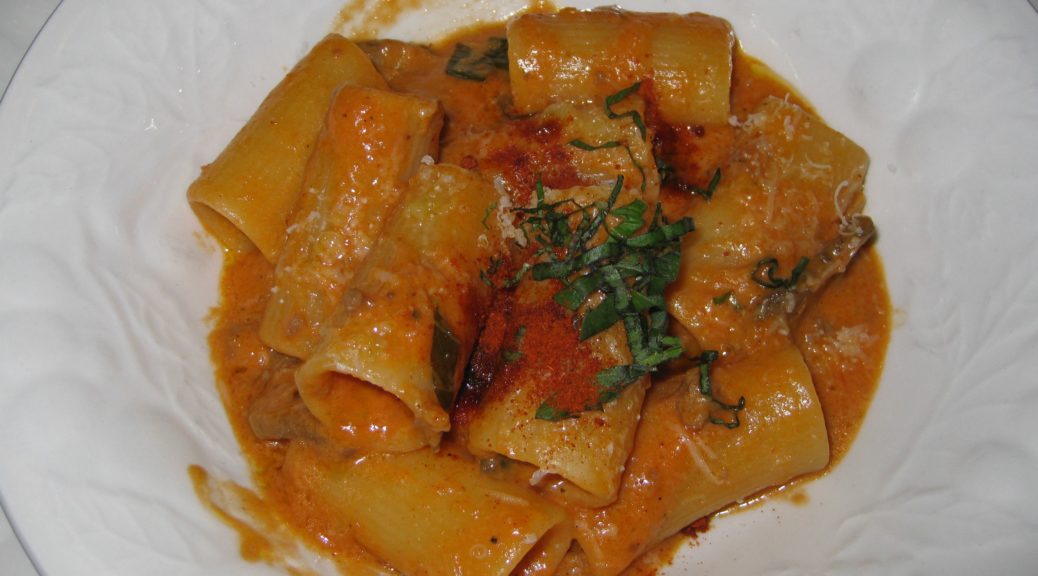May 29, 2019
A Lupara is an 8mm sawn-off shotgun favored by La Cosa Nostra.
It’s also the name of a pasta dish.

I learned to make lupara at the Italian Culinary Institute. It was among the first pasta dishes demonstrated during the early days of the three-month course. Made with short, cut pasta, like rigatoni, this rendition pays tribute to the shotgun for which it is named.
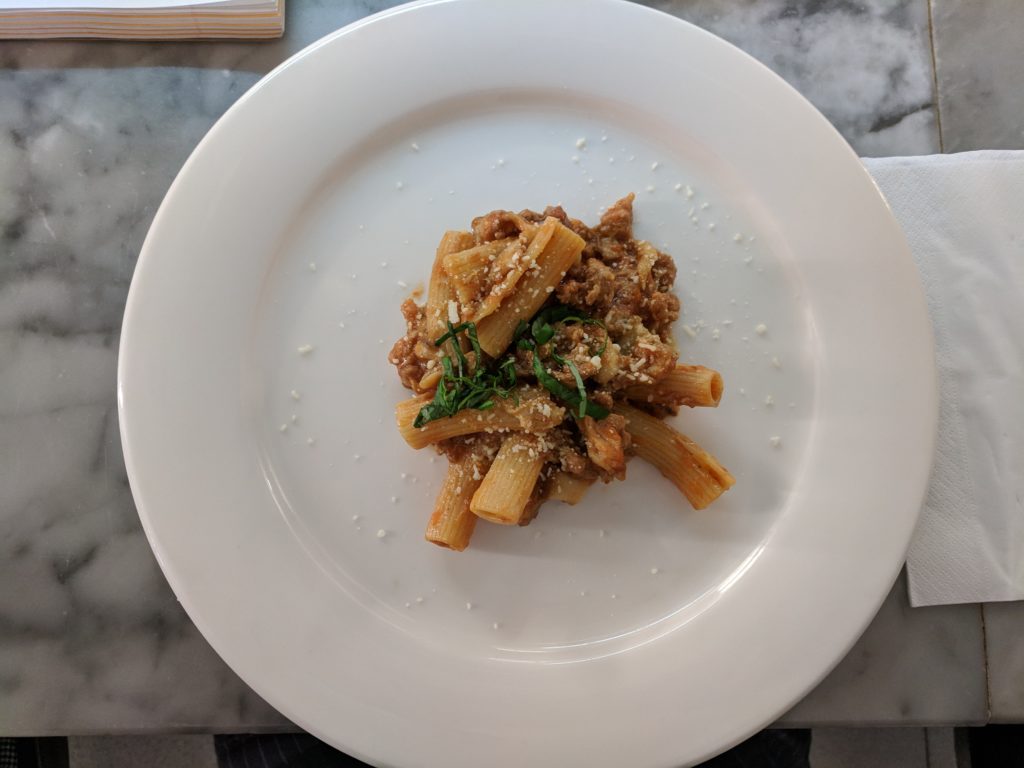
Join our mailing list and you’ll never miss a recipe again!
This dish makes use of a Basic Tomato Sauce, just tomatoes and a few aromatics cooked briefly. You can make the tomato sauce in large batches and freeze it or you can make it as needed. Although the sauce can be used on its own in some dishes, it is deliberately not aggressively seasoned. This allows it to be used in a variety of preparations, with some final additional flavoring, without the sense that the same sauce is being used over and over.
I know this seems a little out of order, but I will publish the recipe for the Basic Tomato Sauce next week For my first blog post since returning from Italy, I wanted to feature a dish that grabbed my attention. This one did. It’s got a great story and a great flavor. Basic Tomato Sauce is good but it isn’t captivating (unlike a pasta dish named after the “Mob’s” favorite weapon!). Basic Tomato Sause is meant to play a supporting role in most situations and that’s just not the type of recipe that I wanted to start with.
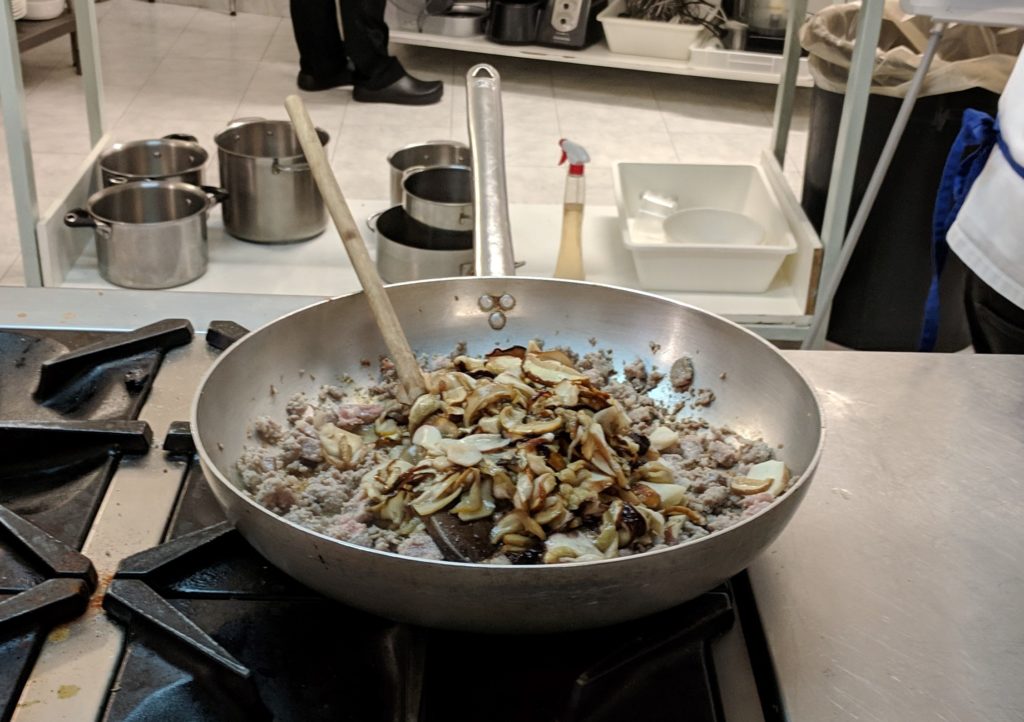
This version of Lupara is intended to be spicy but spicy means different things to different people. There are two ways to build spice into this pasta. You can use one or both of them. The first method is to add dried, ground red pepper (peperoncino piccante in polvere, in Italian) during the final assembly of the pasta. The other is to add thinly sliced fresh hot pepper (peperoncino fresco) when sautéing the sausage. Getting authentic Italian peperoncino, powdered or fresh, is difficult in the States. You can substitute Cayenne pepper for the ground one and a variety of long, red (always red!) chile, such as Thai or Cayenne, for the fresh.
Follow us on your social media platform of choice
![]()
![]()
![]()
This recipe also calls for fresh porcini mushrooms. These can be a challenge to find. Feel free to substitute thinly sliced portobello mushrooms. Though the flavor won’t be exactly the same, the dish will still be yummy! If you are lucky enough to find fresh porcini, I suggest buying a heap, thinly slicing them, and freezing them. They can be used in all sorts of cooked dishes, especially Trifulata which will hit the blog in the near future…as soon as I can find fresh porcini!! (You might notice portobello mushrooms in the pictures.)
This recipe requires a small amount of sausage. It’s not a major player though it does add a nice meaty background note to the sauce. Pick a good quality Italian-style sausage, sweet or hot. I think that sausage with fennel seed adds a nice flavor but that’s a matter of personal taste.
Buon appetito!!
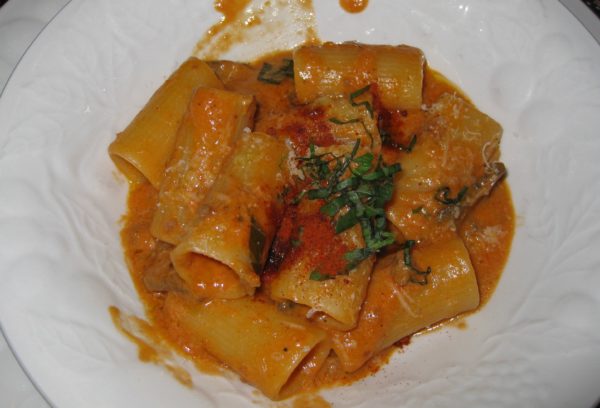
| Prep Time | 30 minutes |
| Cook Time | 30 minutes |
| Servings |
people
|
- 1 batch Basic Tomato Sauce
- 5 ounces Italian-style sausage casing removed and crumbled
- 1 1/3 tablespoons extra virgin olive oil
- 5 ounces fresh porcini thinly sliced
- 1 1/3 tablespoons butter
- 5 ounces dry wine red or white
- 5 ounces vegetable or chicken broth
- 4-5 leaves fresh basil chopped
- Salt and pepper to taste
- 2 1/4 pounds imported Italian rigatoni preferably artisinal
- 4 cloves garlic crushed
- 3 tablespoons extra virgin olive oil
- 3/4 cup heavy cream
- Peperoncino piccante to taste (ground red pepper)
- 3 ounces Parmigiano Reggiano cheese freshly grated
- extra virgin olive oil
- Pecorino Romano cheese freshly grated
- fresh basil cut in chiffonade
Ingredients
Sauce
Assembly
For serving
|

|
- Using a heavy-bottomed pot, sauté the sausage in the olive oil until colored.
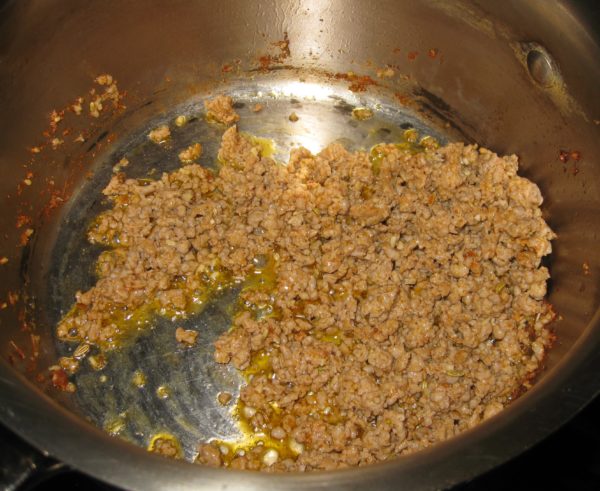
- Add the porcini, butter, and fresh peperoncini, if desired, and sauté 5-7 minutes. During this time, the sausage should brown much more and the mushrooms should give up much of their liquid and take on some color.
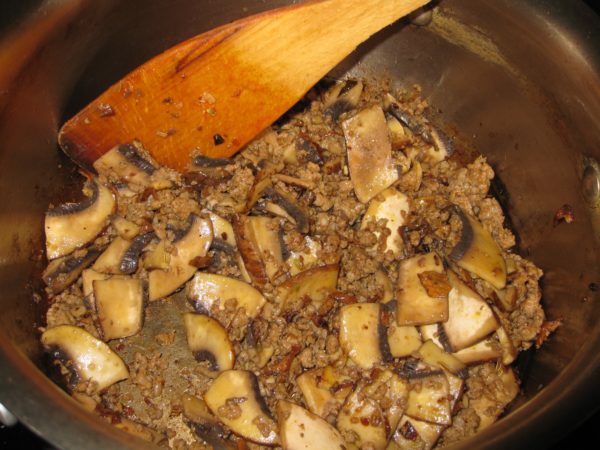
- Add the wine and evaporate completely over high heat.

- Add the broth, partially cover, and simmer until completely evaporated.
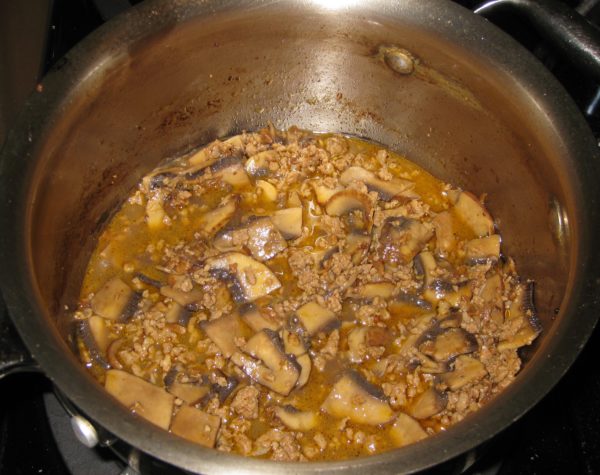
- Add the Basic Tomato Sauce, basil, and salt and pepper to taste. Simmer about 10 minutes. Reserve.
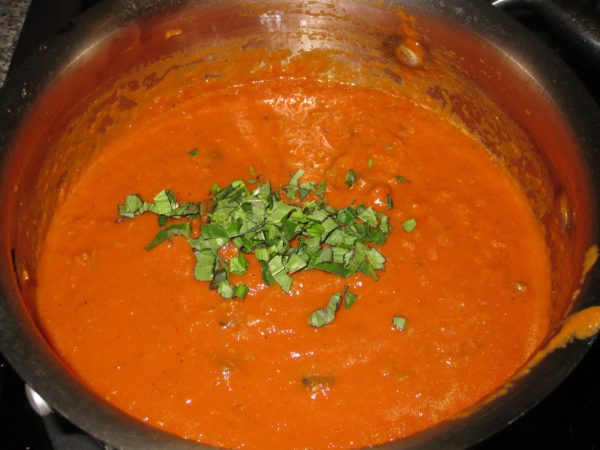
- Bring three quarts of heavily salted water (according to the Italians, it should taste like the sea) to a boil.
- Meanwhile, sauté the garlic in the extra-virgin olive oil until light brown. Drain and reserve the oil.
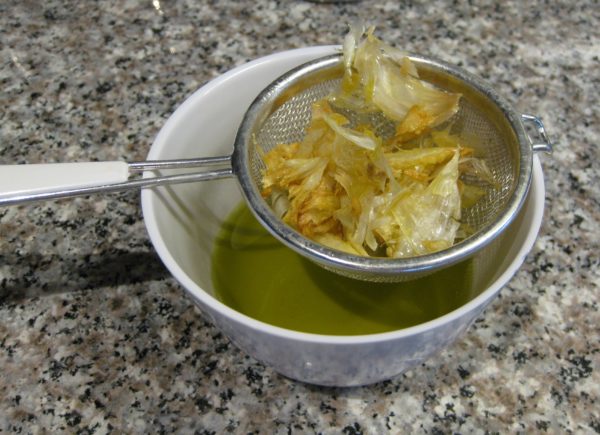
- Cook the rigatoni just until it no longer has a crunch in the center but is still far from done.
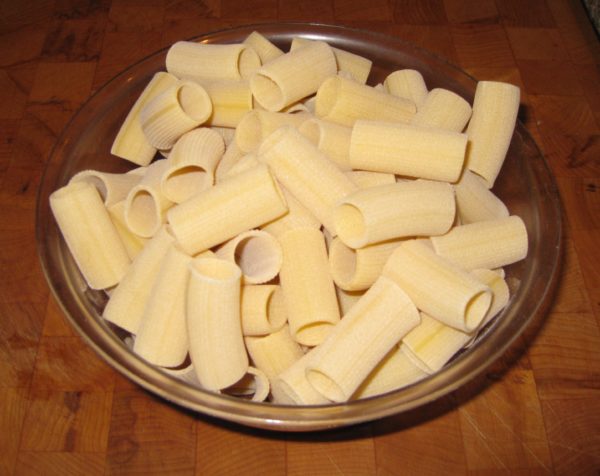
- While the pasta is cooking, put the sauce in a large sauté pan and bring to a simmer along with peperoncino piccate to taste.
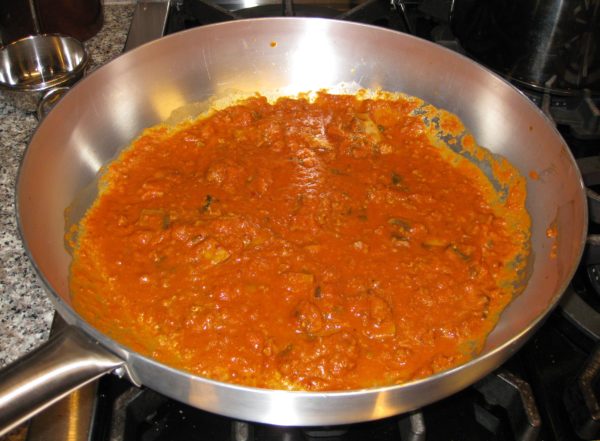
- Drain the rigatoni, saving at least one quart of the pasta-cooking liquid.
- Add the rigatoni to the sauce and increase the heat to medium to medium-high. Add pasta-cooking liquid, a ladle at a time, stirring the pasta frequently to finish cooking.
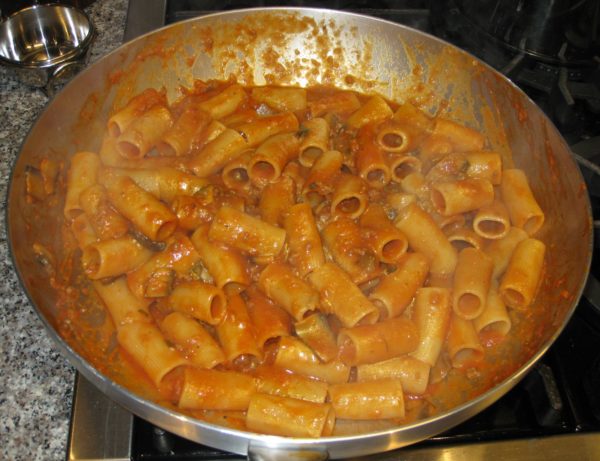
- After adding a ladle or two of the pasta-cooking liquid, add the cream. Continue adding pasta-cooking liquid as needed until the pasta is just al dente and coated with a thick sauce.
- Off the heat, mix in the Parmigiano Reggiano cheese, cream, and the reserved garlic oil. You may need to thin with a little more pasta-cooking liquid as the cheese will thicken and emulsify the sauce.
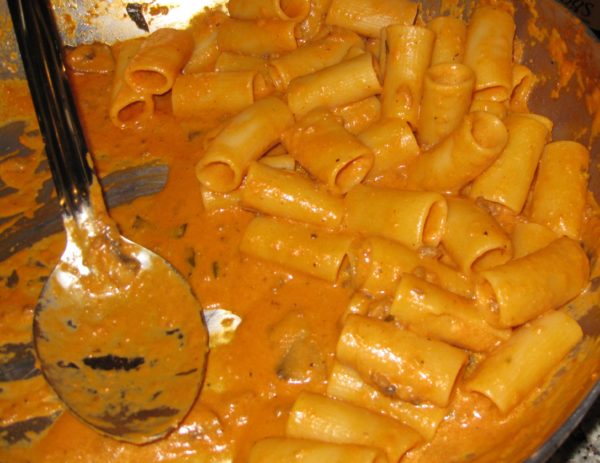
- Divide the pasta among serving bowls. Garnish each with a drizzle of extra-virgin olive oil and sprinklings of Pecorino Romano cheese and fresh basil chiffonade.

Here's my recipe for Basic Tomato Sauce.
Copyright © 2019 by Villa Sentieri, LLC. All rights reserved.

